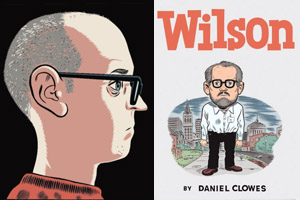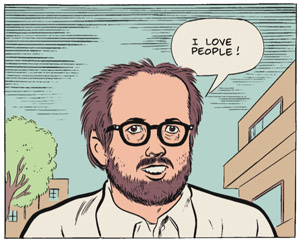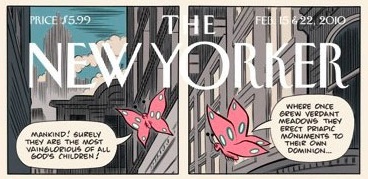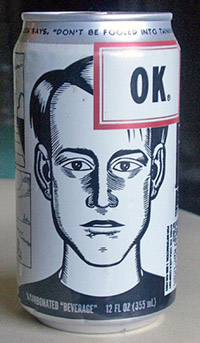
Daniel Clowes/Drawn and Quarterly
It’s not easy to stick a label on Daniel Clowes. In his 30-year-plus career, he’s gone from submitting cartoons to Cracked to drawing New Yorker covers. He’s illustrated a Ramones video and been nominated for an Academy Award for screenwriting. His comics have switched agilely between styles and genres, from the retro kitsch of Lloyd Llewellyn to the grotesque noir of Like a Velvet Glove Cast in Iron, from Pussey!‘s knowing send-up of comic nerddom to Ghost World‘s affecting portrait of teenage melancholy. Newsweek has hailed him as America’s “premier underground cartoonist,” yet that tag barely begins to capture the breadth or depth of his work.
Defying categorization suits Clowes (rhymes with “browse”) just fine. “My generation of cartoonists, we’re not exactly underground. I don’t know what we are. We never had a name exactly,” he explains as he tucks into a midday breakfast at a Berkeley eatery. “That was the best thing that ever happened to us.” In person, the well-adjusted 49-year-old is a comforting contrast to his self-deprecating self-portraits (Ghost World’s 18-year-old female protagonist flees Clowes when he turns out to be a goofy-looking “perv”)—not to mention the assorted oddballs who populate his strips. Clowes describes his newest misfit, Wilson—a middle-aged man whose desire for connection is expressed by his need to sabotage every social interaction—as his “über-nemesis.”
Surprisingly, Wilson is Clowes’ first original graphic novel (another label he dislikes). That wasn’t so much a creative decision as a reflection of the changing state of the comics business, he explains. Most of his previous books were collections of strips he’s published in his comic book Eightball, which he launched in 1989. The last issue of Eightball came out in 2004. “Nobody wants to sell a comic book that’s five dollars. At a certain point I had to face the reality of the marketplace that nobody wants that product,” he says.
Below, Clowes talks more about his new book, his recent heart surgery, and how he broke one of The New Yorker‘s biggest taboos.
Mother Jones: You’ve said that you don’t really care for the term “graphic novel.”
Daniel Clowes: I thought it would never catch on. It’s a terrible term. They’re not novels; most of them are memoirs, in fact. “Graphic” implies an illustrated novel; that’s not what it is. I just thought people would say, “It’s a comic book, why are you trying to trick us?” But it worked: “Graphic novel” now means something very specific. People hear those two words and take them to mean a type of book that is generally correct. I give up—it works. The branding guys won.
MJ: That reminds me of the character in Ice Haven who describes “graphic novel” as a “vulgar marketing sobriquet.”
DC: I had fun with that. I also called it a “narraglyphic picto-assemblage.” When I went on my little book tour for that book, two or three people introducing me would say, “Among his many narraglyphic picto-assemblages are Ghost World…”—they just absolutely took it seriously. It’s hopeless.
MJ: It seems like that’s an extension of the “comics aren’t just for kids” theme that’s always mentioned in reviews—you can also take comics way too seriously.
DC: It gets absurd. It’s interesting that this topic is always of great interest—what are these called? My generation of cartoonists, we’re not exactly underground. I don’t know what we are. We never had a name, exactly. People would say “alternative,” but that wasn’t quite right. Or they’d say “post-underground.” There were all these terms that never stuck. I always thought that was the best thing that ever happened to us. We didn’t get pigeonholed as the ’90s cartoonists. We didn’t have a name, so we got to drift a long through the decades without being pinned into this clique.
MJ: I just read Wilson. I’m glad that you took on people who talk at you without your permission.
DC: You live in Berkeley, so you know it well. When my wife read the first half of the book she said, “This guy is like your über-nemesis—he’s all the things that assault you on a daily basis.” I think that’s sort of true, but I also sort of admire a guy who can sit down at a table and just talk to somebody, even though he fails miserably at making a connection.
 MJ: Here’s this guy who thinks he’s being honest and open yet he’s totally self-absorbed and always ends up in a communication breakdown. It made me think about Curb Your Enthusiasm, which always makes me wonder what it would be like to say whatever’s on your mind. After reading Wilson, I realized this is what it would really be like—you’d be an outcast!
MJ: Here’s this guy who thinks he’s being honest and open yet he’s totally self-absorbed and always ends up in a communication breakdown. It made me think about Curb Your Enthusiasm, which always makes me wonder what it would be like to say whatever’s on your mind. After reading Wilson, I realized this is what it would really be like—you’d be an outcast!
DC: Well, Larry David has this superpower that he’s a billionaire. So he can do whatever he wants. Wilson has no visible means of support.
MJ: Wilson is set in Oakland, which is the first time I’ve recognized a specific city in one of your comics.
DC: The strip I did for the New York Times Magazine, “Mister Wonderful,” that’s set on and around Piedmont Avenue. This one’s set more on Grand Avenue. My house is sort of in between those two, so they’re the polarities of my little world.
MJ: A lot of your older stuff is set in a generic, anonymous urban setting.
DC: It’s a combination of Berkeley, Chicago, and Brooklyn—the three places where I’ve spent the most time. Which somehow flattens out to seem like suburbia, which is weird. But if you draw a place like Brooklyn accurately, it really does look like suburbia.
MJ: So you were buddies with Chris Ware in Chicago?
DC: Just by some miracle, without knowing where I lived, he moved a tennis ball’s throw away from me. He was living four buildings away. I could almost see his window; it was so odd. So we became really good friends.
MJ: And when you came out to Berkeley you met Adrian Tomine?
DC: It turned out he was in one of my wife’s classes. I had gotten his comics and thought, “This guy isn’t a college student, he’s way too good. He’s gotta be like 33 or something like that.” Of course, he was 19 at the time. And it turned out he lived five doors away from me in Brooklyn. Those two guys were like the best two cartoonists to come along in the last 20 years, and to have them both miraculously wind up on the same block was very strange.
MJ: Now the three of you and a bunch of other cartoonists are drawing covers for The New Yorker. How did that come about?
DC: The cover editor is Françoise Mouly, who is Art Spiegelman’s wife, who is truly a devoted patron of our little clique of cartoonists. So far, no one’s complained—I keep waiting for someone to say, “Get rid of those guys! Enough with the comics!” There’s a certain formula where a New Yorker cover is not exactly a joke. I kept submitting ideas that were like ha-ha funny jokes, and that’s not what it is. It’s its own type of image that creates a certain response that is not a laugh but is amusement of some kind. Once you get it, everything becomes a New Yorker cover. But it was many years before I got what that actually was.
 MJ: Recently, you, Ware, Tomine, and Ivan Brunetti created four covers that formed a hidden image when you put them together.
MJ: Recently, you, Ware, Tomine, and Ivan Brunetti created four covers that formed a hidden image when you put them together.
DC: That was such a pain in the ass! Now that it’s all done, I’m glad we did it. The only editorial comment I’ve ever gotten was on that cover where I used the word “priapic.” David Remnick said, “There’s no penis jokes on our covers. That will never happen.” I folded immediately, but Francoise was like, “No, that’s the perfect word; it’s essential.” We fought for it and Remnick was like, “Okay, I give up.” So I got the first penis joke on The New Yorker. It opens the floodgates…
(Wilson panel courtesy Drawn and Quarterly)
MJ: I assume you don’t usually work with an editor.
DC: Never. I never know if a book is crazy or not. There’s that fear—this is the one that will end it all. With Wilson, I think worst-case scenario, it will be funny and painless to read. But I’m still not sure how it will be received.
MJ: I enjoyed it a lot—even though I was depressed by it. Not in a bad way—
DC: No, I sort of take that as a compliment.
MJ: You had open-heart surgery recently—what happened?
DC: I was 45 or so and just noticed I wasn’t as spry as I used to be. My doctor listened to my heart and heard a little something there and told me to see a cardiologist. It just happened to be a year when I had really good health insurance—it was like $1,000, and I never would have ever gone otherwise. The cardiologist said, “Your heart is twice the size it should be and you have a very serious leaking valve and if you don’t get this fixed you have two or three years left.” It was terrible. I had to go in for surgery and they repaired it, luckily, and it’s back down to regular size. It’s one of those miraculous surgeries—it’s sort of like origami. I probably will be fine for the rest of my life. But I was very sympathetic to the health care debate after that. The operation cost, I think, $300,000.
MJ: How’d you get into comics? Were you a fanboy?
DC: I was. I had an older brother who was an inveterate comic reader and I inherited a stack of comics without covers—for some reason he always ripped the covers off. We didn’t have TV, so it was always, “Go read your comics!” Before I could read, I remember trying to piece together the stories from the images. It was a very primal experience.
MJ: What is it about comics that breeds obsessiveness?
DC: It’s a world that you can exert control over. I started drawing at a very young age. Writing a story wasn’t satisfying, but to actually draw our own world—it’s like controlling your own dreams.
MJ: That was the message of Pussey, which is about an impotent guy who dreams about superheroes all the time. As well as being a satire of fanboys and the comics industry.
DC: That was so specific to 1989. Nobody had done anything like that before, making fun of comics fans. Now, that’s such a commonplace thing; everyone’s so familiar with that world. There’s Comic-Con every year, which gets 100,000 people. Back then, it was like 1,500 people and that was it; that was all the comic geeks in the world. It seemed like this sad little world—which it still does, but it’s a sad big world. When I was in high school, if you said you liked superheroes or Lord of the Rings, you were just like a hopeless reject, and now those are the biggest things in the world. Even Avatar is a total nerd thing, and yet our popular culture has somehow made all that stuff acceptable.
MJ: So what are the outsider nerds into now?
DC: I don’t think there are any outsiders anymore. It’s good for the outsiders; I don’t know if it’s good for our culture. I think it was good to have this mass culture that we all reacted to in some way. I was thinking the other day that there will never be another form of music that everybody has to respond to—like disco.
 MJ: I have to ask about OK Soda—this short-lived early-’90s soda that you illustrated a can for.
MJ: I have to ask about OK Soda—this short-lived early-’90s soda that you illustrated a can for.
DC: I never saw it—it was gone in two months. It was fast. I didn’t quite get that Coca-Cola was doing it; it was just this ad agency that contacted me. The way that face on the can was created, the original character I used was based on Charles Manson; the eyes on the guy are absolutely Charles Manson’s eyes. I thought that would be a great thing to announce two years afterward. Now, there’s like a whole cult devoted to OK; the cans are quite valuable.
MJ: You recently drew a strip for the San Francisco Panorama, Dave Eggers’ newspaper project. How do you think that turned out?
DC: I don’t know if it has any use at all as a project that anyone could ever do again. But as a single magazine, it sure was fun to read. After I got it, it was all I read for six weeks. It had so many great ideas I wish papers had. [Eggers] had this notion that if you had this big size you could get cartoonists to do a weekly strip—but you couldn’t. It took me a week to do that one strip.
MJ: The Panorama was a celebration of print newspapers, yet the big, full-color comics page has been gone for ages.
DC: Since the ’30s! It could be done again—printing is now as cheap as it’s ever been. But who would you get to do it?
MJ: A lot of web cartoonists have figured out a way to do daily or weekly strips.
DC: That’s true. It’s interesting how people have gravitated toward this awful grind of doing a daily strip. I can’t think of anything worse.
(OK Soda photo by Flickr user janetgalore used under a CC License)
















